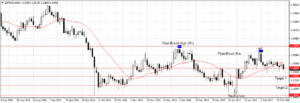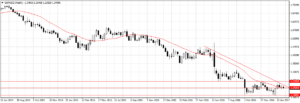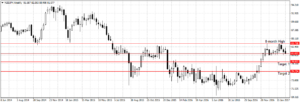- Forex Weekly Outlook February 20-24
The US dollar gained against its counterparts last week, after data showed producers price index rose 0.6 percent and inflation also surged 0.6 percent in January. Buttressing the general perception that increased in gasoline cost will pressure consumer prices above the Fed 2 percent inflation target and force the FOMC to adjust interest rates.
However, wage growth remained below projection, plunging to 2.5 percent from 2.8 percent recorded in December, which is capable of hurting consumer spending (0.4%) that has been supporting the economy if the Fed hike rate with declining wages. Therefore, it’s unlikely the fed will move this March as widely speculated, however, Trump new tax policy due to be announced this week can change this view.
On tax policy, the possibility of law makers cutting corporate tax to 20 percent from current 35 percent and the Fed’s hawkish outlook boosted the attractiveness of the US dollar last week. Although, retail business owners are worried that the proposed border tax on import goods will hurt revenues and subsequently affect wages, law makers insisted it will help generate about $1 trillion needed to reduce the deficit. Hence, it is hard to quantify or deduce the US dollar direction ahead of new tax policy.
In the UK, the consumer spending (0.3%) that has been supporting the economy dropped for a third consecutive month in January, signaling that post-Brexit resilience is gradually coming to an end as high consumer prices (food and fuel) seems to have started hurting purchasing power even before March – stipulated date for triggering Brexit.
Consequently, job creation is gradually slowing down, according to the statistics office report for the final quarter of 2016. Also, pay growth fell to 2.6 percent in the same quarter, while labour market is still strong, the pace has cooled in recent time over Brexit uncertainty. Therefore, this is expected to weigh on the British Pound and render it unattractive as investors continued to look elsewhere to avert lost.
In New Zealand, consumer spending remains steady in the last quarter of 2016. Rising 0.8 percent, but the New Zealand dollar declined against its counterparts after RBNZ governor said the continuous gain of the currency could impede growth. Prompting traders to sell-off the haven currency. Overall, the global financial market remains vague ahead of Europe uprising and uncertainty in the US.
This week, GBPUSD and NZDJPY top my list.
GBPUSD
The series of events happening in the Euro-area continued to weigh on the pound outlook. However, Brexit and drop in consumer confidence standout. Whereas the US dollar remained strong and likely to continue so.

Click to enlarge
Technically, after the pair peaked at 1.2773 in December, its highest post-Brexit, it has lost about 363 pips and failed to top 1.2704 price levels attained this February. Again, the pair is trading below 20-days moving average on the daily candlestick and closed below weekly 20-days moving average, after the doji formed two weeks ago. Indicating the pressure is on the downside as the U.K. prepare to trigger article 50 next month.

Click to enlarge
This week, I am bearish on GBPUSD as long as 1.2500 holds and will be looking to sell below 1.2426 price levels for 1.2297 targets, a sustained break should open up 1.2148 in days to come. But a negative comment or perceived negative new policy from the U.S. can void this analysis as the world await Trump new tax policy.
NZDJPY
Last week, I wrote extensively on the New Zealand dollar outlook. While the economy remains strong and well-supported by the surging commodity prices, traders seem to be selling the pair after Governor Graeme Wheeler statement on the danger of high foreign exchange to the economy.

Click to enlarge
The pair called the top at 83.79 price levels, its 8-month high, and dropped 280 pips to close at 81.07 price levels. One of the reasons this is a good sell is the renewed interest in the Japanese yen as investors scramble for safe-haven assets ahead of numerous changes that will be taking place across the Group 8 nations. Again, I don’t think the pair is attractive enough to top its 8-month high after RBNZ statement. Hence, I am bearish on this pair this week and will be looking to sell below 81.02 support for 78.83 targets, a sustained break should boost its attractiveness for 76.23 targets 2.
Last Week Recap
NZDUSD closed below the channel last week but failed to meet our target of 0.6989. However, I remain bearish on NZDUSD this week, one, for the reasons stated above, and two, the continuous gain of the US dollar should aid NZDUSD bearish move below 0.7124 support levels, that also serves as 20-days moving average.

Click to enlarge